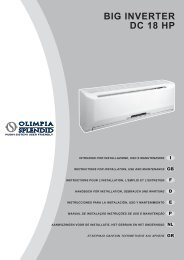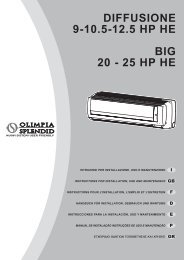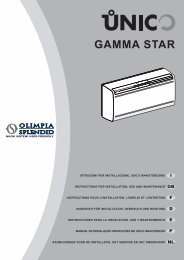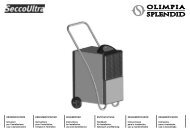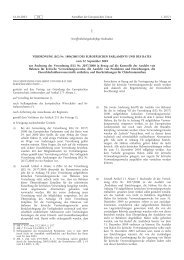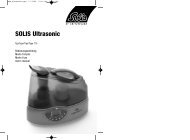MANUALE MULTIFLEXI INVERTER.pmd - KlimaShop!
MANUALE MULTIFLEXI INVERTER.pmd - KlimaShop!
MANUALE MULTIFLEXI INVERTER.pmd - KlimaShop!
Create successful ePaper yourself
Turn your PDF publications into a flip-book with our unique Google optimized e-Paper software.
98<br />
3<br />
3.18<br />
I<br />
PROBLEMI NON INERENTI AL<br />
CONDIZIONATORE<br />
Se si verificano le seguenti condizioni,<br />
il condizionatore funziona correttamente.<br />
- Protezione comune per il<br />
compressore<br />
Non è possibile avviare il<br />
compressore nei primi 3 minuti.<br />
Comando aria calda (modalità<br />
raffreddamento e riscaldamento)<br />
Nella modalità HEAT, la velocità<br />
del ventilatore interno viene<br />
ridotta automaticamente o viene<br />
addirittura arrestato per evitare<br />
una corrente di aria fredda, se<br />
non è stata raggiunta la<br />
temperatura impostata dello<br />
scambiatore di calore, in queste<br />
tre situazioni:<br />
1 Appena avviata la modalità<br />
riscaldamento<br />
2 Sbrinamento<br />
3 Riscaldamento ad una<br />
temperatura bassa<br />
- Sbrinamento (modelli<br />
sbrinamento e riscaldamento)<br />
Quando la temperatura<br />
esterna è bassa e l'umidità<br />
elevata, si può formare del<br />
ghiaccio sullo scambiatore di<br />
calore esterno; ciò può ridurre la<br />
capacità di riscaldamento del<br />
condizionatore. Il condizionatore<br />
arresta la modalità riscaldamento<br />
ed avvia automaticamente<br />
quella di sbrinamento. Una volta<br />
terminato lo sbrinamento,<br />
riavvierà la modalità riscaldamento.<br />
1 durante il funzionamento in<br />
modalità sbrinamento i<br />
ventilatori delle unità interne<br />
ed esterna si arresteranno.<br />
2 il tempo di sbrinamento<br />
dipende dalla temperatura<br />
esterna e dal quantitativo di<br />
ghiaccio presente (varia dai 4<br />
ai 10 minuti).<br />
3 durante lo sbrinamento,<br />
potrebbe uscire del fumo<br />
bianco dall'unità esterna. Ciò<br />
è causato dallo sbrinamento<br />
rapido ed è normale.<br />
- Fumo bianco che<br />
fuoriesce dall'unità interna<br />
- Quando il funzionamento è in<br />
modalità "raffreddamento" in<br />
presenza di un'umidità elevata,<br />
potrebbe fuoriuscire del fumo<br />
bianco causato dall'umidità<br />
elevata e dalla forte differenza<br />
di temperatura.<br />
- Una volta terminato lo<br />
sbrinamento, il condizionatore<br />
i porterà automaticamente<br />
sulla modalità riscaldamento,<br />
l'acqua prodotta durante lo<br />
sbrinamento si trasforma in<br />
fumo e fuoriesce dall'unità<br />
interna.<br />
- Leggero rumore del<br />
condizionatore<br />
- Quando il condizionatore è in<br />
funzione nelle modalità<br />
"Automatica", "Raffreddamento",<br />
"Deumidificazione" o "Riscaldamento",<br />
si può avvertire un<br />
sibilo causato dal flusso di<br />
refrigerante tra l'unità interna<br />
ed esterna.<br />
TROUBLES NOT<br />
CONCERNING AIR<br />
CONDITIONER<br />
GB F D<br />
If any of the following conditions<br />
occur your air conditioner is in order.<br />
- Common protection for<br />
compressor<br />
You can't start compressor<br />
within 3 minute.<br />
Warm air control (cooling and<br />
heating type) Under the HEAT<br />
mode, the indoor fan speed is<br />
automatically reduced or stopped<br />
to prevent a cold draft if the set<br />
temperature of the indoor heat<br />
exchanger has not been reached<br />
under the following three<br />
situations:<br />
1 Just start heating operation<br />
2 Defrosting<br />
3 Heating in a low temperature<br />
- Defrosting (defrosting<br />
and heating type)<br />
Frost may be generated on<br />
Outdoor Heat Exchanger when<br />
outdoor temperature is low and<br />
humidity is high, It would lower<br />
heating efficiency of the<br />
conditioner. The air conditioner<br />
would stop heating operation<br />
and start defrosting<br />
automatically. After finishing the<br />
defrosting, it will restart<br />
heating operation.<br />
1 the fans in both the indoor and<br />
outdoor units will stop running<br />
during defrosting operation<br />
2 the time of defrosting is<br />
different according to the<br />
outdoor temperature and frost<br />
degree (for approximately<br />
4 - 10 minutes).<br />
3 During defrosting, white smog<br />
may be come out from outdoor<br />
unit. This is caused by quickly<br />
frosted and it’s a normal case.<br />
- White smog discharged<br />
from indoor unit<br />
- When running under “cooling”<br />
mode at the place with high<br />
humidity, white smog may<br />
come into being because of<br />
high humidity and high<br />
difference in temperature.<br />
- When the air conditioner finish<br />
the defrosting, it will<br />
automatically turn to heating<br />
operation, the water produced<br />
during defrosting will change<br />
into smog and come out from<br />
indoor unit.<br />
- Low noise of air<br />
conditioner<br />
- When air conditioner is in<br />
“Automatic”, “Cooling”,<br />
“Dehumidifying” or “Heating”<br />
operating, there may be some<br />
“ss” sound caused by the<br />
flowing between indoor and<br />
outdoor unit of refrigerant.<br />
PROBLEMES NE CONCER-<br />
NANT PAS LE CLIMATISEUR<br />
Si les conditions suivantes se<br />
présentent, le climatiseur fonctionne<br />
correctement.<br />
- Protection commune<br />
pour le compresseur<br />
Il est impossible de mettre le<br />
compresseur en marche pendant<br />
les 3 premières minutes.<br />
Commande d'air chaud (mode<br />
refroidissement et chauffage). En<br />
mode HEAT, si l'échangeur de<br />
chaleur n'a pas atteint la<br />
température sélectionnée, il y a<br />
réduction automatique de la<br />
vitesse du ventilateur ou arrêt de<br />
celui-ci pour éviter un courant<br />
d'air froid, dans les trois<br />
situations suivantes:<br />
1 Dès le démarrage du mode<br />
chauffage<br />
2 Dégivrage<br />
3 Chauffage à une température<br />
basse<br />
- Dégivrage (modèles<br />
dégivrage et chauffage)<br />
Quand la température extérieure<br />
est basse et que l'humidité est<br />
élevée, de la glace peut se<br />
former sur l'échangeur de<br />
chaleur extérieur; ceci peut<br />
réduire la capacité de chauffage<br />
du climatiseur. Le climatiseur<br />
arrête le mode chauffage et<br />
démarre automatiquement le<br />
mode dégivrage. Une fois le<br />
dégivrage terminé, il redémarre<br />
le mode chauffage.<br />
1 pendant le fonctionnement en<br />
mode dégivrage, les<br />
ventilateurs des unités<br />
intérieures et extérieure<br />
s'arrêtent.<br />
2 le temps de dégivrage dépend<br />
de la température extérieure<br />
et de la quantité de glace<br />
présente (de 4 à 10 minutes).<br />
3 pendant le dégivrage, il se peut<br />
que de la fumée blanche sorte<br />
de l'unité extérieure. Ceci est<br />
dû au dégivrage rapide et c'est<br />
normal.<br />
- Fumée blanche qui sort<br />
de l'unité intérieure<br />
- Quand le fonctionnement est<br />
en mode "refroidissement", en<br />
présence d'une humidité<br />
élevée, il se peut que de la<br />
fumée blanche due à la forte<br />
humidité et au grand écart de<br />
température sorte de l'unité<br />
intérieure.<br />
- Une fois le dégivrage terminé,<br />
le climatiseur se met automatiquement<br />
en mode chauffage,<br />
l'eau produite pendant le<br />
dégivrage se transforme en<br />
fumée et sort de l'unité<br />
intérieure.<br />
- Léger bruit du climatiseur<br />
- Quand le climatiseur<br />
fonctionne en mode "Automatique",<br />
"Refroidissement",<br />
"Déshumidification" ou<br />
"Chauffage", il se peut que<br />
vous entendiez un sifflement<br />
dû au flux de réfrigérant entre<br />
l'unité intérieure et extérieure.<br />
NICHT AUF DIE KLIMAAN-<br />
LAGE ZURÜCKZUFÜHREN-<br />
DE PROBLEME<br />
Wenn folgende Bedingungen<br />
gegeben sind, arbeitet die Klimaanlage<br />
auf korrekte Weise.<br />
- Allgemeiner Schutz für<br />
den Kompressor<br />
Schutz für den Kompressor der<br />
Start des Kompressors in den<br />
ersten 3 Minuten ist nicht<br />
möglich.<br />
Ansteuerung heiße Luft<br />
(Betriebsart Kühlung und Heizung.)<br />
In der Betriebsart HEAT wird die<br />
Geschwindigkeit des<br />
Innenventilators automatisch<br />
reduziert oder der Ventilator sogar<br />
abgeschaltet, um einen<br />
Kaltluftstrom zu vermeiden, wenn<br />
die eingestellte Temperatur des<br />
Wärmetauschers nicht erreicht<br />
worden ist. Dies gilt für folgende<br />
drei Situationen:<br />
1 Die Betriebsart Heizung<br />
wurde gerade gestartet<br />
2 Abtauen<br />
3 Heizung bei einer niedrigen<br />
Temperatur<br />
- Abtauen (Modelle Abtau<br />
en und Heizung)<br />
Wenn die Außentemperatur<br />
niedrig und die Feuchtigkeit hoch<br />
ist, kann sich Eis auf dem<br />
externen Wärmetauscher bilden.<br />
Dies kann die Heizkapazität der<br />
Klimaanlage reduzieren. Die<br />
Klimaanlage schaltet die<br />
Betriebsart Heizung ab und<br />
startet automatisch die<br />
Abtaufunktion. Nach Abschluss<br />
des Abtauzyklus wird die<br />
Betriebsart Heizung neu gestartet.<br />
1 Während des Betriebs in der<br />
Betriebsart Abtauen schalten<br />
die Ventilatoren der Innen- und<br />
Außeneinheit ab.<br />
2 Die Abtauzeit hängt von der<br />
Außentemperatur und der<br />
Menge vorhandenen Eises ab<br />
(variiert zwischen 4 und 10<br />
Minuten).<br />
3 Während des Abtauens könnte<br />
weißer Dampf aus der<br />
Außeneinheit austreten. Dies<br />
wird durch den schnellen<br />
Abtauvorgang verursacht und<br />
ist normal.<br />
- Weißer Dampf tritt aus<br />
der Inneneinheit aus<br />
- In der Betriebsart "Kühlung"<br />
kann beim Auftreten hoher<br />
Feuchtigkeit weißer Dampf<br />
aufgrund dieser Feuchtigkeit<br />
und der hohen Temperaturunterschiede<br />
austreten.<br />
- Nach Abschluss des<br />
Abtauvorgangs stellt sich die<br />
Klimaanlage automatisch in die<br />
Betriebsart Heizung. Das<br />
während des Abtauens produzierte<br />
Wasser wird in Dampf umgewandelt<br />
und tritt aus der Inneneinheit<br />
aus.<br />
- Leichtes Geräusch der<br />
Klimaanlage<br />
- Wenn die Klimaanlage in der<br />
Betriebsart "Automatik",<br />
"Kühlung", "Entfeuchtung" oder<br />
"Heizung" arbeitet, kann ein<br />
Zischen aufgrund des<br />
Kühlmittelstroms zwischen der<br />
Innen- und Außeneinheit<br />
wahrgenommen werden.



